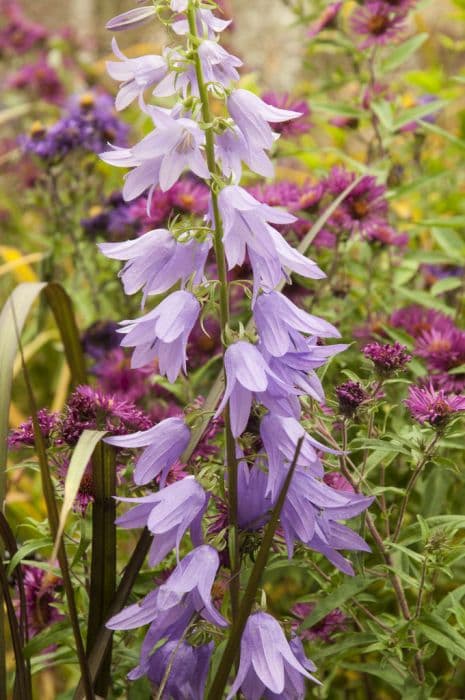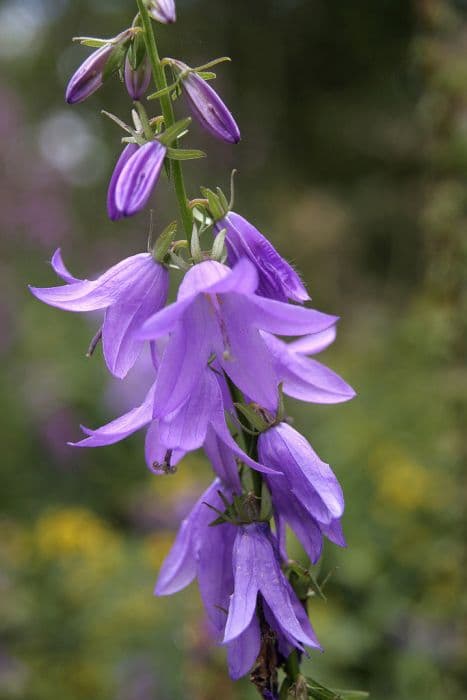Adriatic Bellflower Campanula garganica

ABOUT
The plant commonly referred to as the Adriatic bellflower features star-shaped, radiant blue flowers with lighter or white centers, creating a striking visual contrast against the lush, green foliage. The leaves are heart-shaped, with a tendency to form a low-spreading mat, suggesting a cascading habit that adds to its charm. When in bloom, the profusion of flowers creates a carpet of blue that resembles a piece of the sky resting upon the ground. The overall texture of the plant is delicate and fine, inviting close inspection to appreciate its intricate beauty. The appearance of the plant is characterized by the cheerfulness of the blooms and a sense of whimsy that makes it a favorite for gardeners looking to add a splash of color to rock gardens or along the edges of pathways.
About this plant
 Names
NamesFamily
Campanulaceae
Synonyms
Adriatic Bellflower, Dalmatian Bellflower
Common names
Campanula garganica var. pelviformis, Campanula pelviformis, Campanula pelviformis var. longistyla, Campanula pelviformis var. garganica, Campanula fingens, Campanula garganica var. cavanillesii.
 Toxicity
ToxicityTo humans
The Adriatic bellflower (Campanula garganica) is generally not considered toxic to humans. There are no well-documented cases or studies indicating that this plant is poisonous, and it does not appear on toxic plant lists. Thus, ingestion of this plant is not expected to cause harm. However, it is advisable to avoid consuming any plant not designated as food, as individual sensitivities or allergic reactions could occur.
To pets
The Adriatic bellflower (Campanula garganica) is not known to be toxic to pets such as cats and dogs. It's not listed in the databases of toxic plants for animals. Nonetheless, it's important for pet owners to prevent their pets from eating plants indiscriminately, as gastrointestinal upset or an unexpected allergic reaction could occur. If a pet does consume the plant and shows signs of distress, contacting a veterinarian is recommended.
 Characteristics
CharacteristicsLife cycle
Perennials
Foliage type
Deciduous
Color of leaves
Green
Flower color
Blue
Height
0.5 feet (15 cm)
Spread
1 foot (30 cm)
Plant type
Herb
Hardiness zones
7
Native area
Mediterranean
Benefits
 General Benefits
General Benefits- Aesthetic Appeal: Campanula garganica, commonly known as the Adriatic bellflower, adds visual interest to gardens with its star-shaped blue flowers and mat-forming habit.
- Attracts Pollinators: The blooms of the Adriatic bellflower attract bees and butterflies, which are essential for pollination and maintaining biodiversity.
- Low Maintenance: Once established, the Adriatic bellflower is relatively low maintenance, requiring minimal care beyond occasional watering and trimming.
- Drought Tolerance: The plant is quite drought-tolerant, making it a suitable choice for rock gardens and dry landscapes.
- Ground Cover: Its growth habit makes it an excellent ground cover, reducing soil erosion and suppressing weed growth.
 Medical Properties
Medical PropertiesThis plant is not used for medical purposes.
 Air-purifying Qualities
Air-purifying QualitiesThis plant is not specifically known for air purifying qualities.
 Other Uses
Other Uses- Adriatic bellflower can be used to create a whimsical, fairy garden setting. Its delicate blue flowers can be set among miniature accessories to evoke an enchanted atmosphere.
- In model landscaping, such as for train sets or architectural models, the small-scale foliage and flowers of the Adriatic bellflower can add a touch of realism to miniature scenes.
- Adriatic bellflower petals can be used in crafting, specifically for pressing. Once dried and pressed, they can be used to decorate note cards, bookmarks, or picture frames.
- Edible garnishing may be an occasional use, as some Campanula species' flowers are edible. They can add color to salads or desserts, assuming no pesticides have been used.
- This plant's trailing habit can be used to create living mulch, covering the soil between other plants, reducing weeds, and retaining soil moisture.
- Adriatic bellflower can be planted in containers and allowed to cascade down the sides, providing an attractive feature to balconies or hanging baskets.
- The vibrant blooms can be used in nature photography to add depth and interest to garden photographs, drawing the attention of viewers with their star-shaped flowers.
- It can be used in dye making, as the flowers may provide natural pigments for textile or craft dyeing processes.
- Used in educational settings, the Adriatic bellflower can help teach children or students about pollinators, as its flowers attract bees and butterflies.
- As groundcover for rock gardens or alpine plantings. Adriatic bellflower thrives in well-draining soils, making it a low-maintenance option for rocky, sloped terrain.
Interesting Facts
 Feng Shui
Feng ShuiThe Adriatic bellflower is not used in Feng Shui practice.
 Zodiac Sign Compitability
Zodiac Sign CompitabilityThe Adriatic bellflower is not used in astrology practice.
 Plant Symbolism
Plant Symbolism- Perseverance: Campanula garganica, commonly known as the Adriatic bellflower, often grows in rocky, challenging environments, symbolizing the ability to thrive despite difficulties.
- Gratitude: The bell-like shape of its flowers can be seen as a metaphor for an open heart, conveying thankfulness and appreciation.
- Constancy: The Adriatic bellflower's long blooming period represents fidelity and everlasting love, making it a popular choice in romantic bouquets.
- Humility: Due to its unassuming size and delicate features, the flower symbolizes modesty and the understated beauty found in simplicity.
 Water
WaterAdriatic bellflower should be watered regularly to maintain evenly moist soil, especially during the growing season. It is recommended to water the plant once a week with about 1/4 to 1/2 gallon of water, depending on the size of the pot and the environmental conditions. Ensure that the pot has good drainage to prevent waterlogging, as standing water can lead to root rot. During the winter months, reduce watering to every other week, allowing the top inch of soil to dry out between waterings. Always use lukewarm water to avoid shocking the plant's roots.
 Light
LightAdriatic bellflower thrives in conditions where it can receive full sun to partial shade. The ideal spot for this plant is where it will be exposed to morning sunlight and receive some shade during the hottest part of the afternoon. It can also tolerate light shade but might not flower as abundantly.
 Temperature
TemperatureAdriatic bellflower prefers a temperature range of 60°F to 75°F during the day and should not be exposed to temperatures below 50°F for extended periods. The plant can tolerate brief dips down to 40°F, but prolonged exposure to cold can be detrimental. Maintain the plant in an environment within these temperature ranges for optimal growth and flowering.
 Pruning
PruningPrune the Adriatic bellflower to maintain its shape and encourage more vigorous growth. Deadheading spent flowers will promote continuous blooming throughout the season. Prune the plant back by about one-third in late winter or early spring before new growth begins, which helps to rejuvenate and prepare the plant for the growing season.
 Cleaning
CleaningAs needed
 Soil
SoilThe Adriatic bellflower thrives best in a well-draining soil mix composed of loam, peat, and sharp sand with a slightly acidic to neutral pH of about 6.0 to 7.5. Regular addition of compost or well-rotted manure will enrich the soil nutrients.
 Repotting
RepottingAdriatic bellflowers should be repotted every 2 to 3 years to refresh the soil and accommodate root growth. Best done in spring or after flowering.
 Humidity & Misting
Humidity & MistingAdriatic bellflowers prefer moderate humidity levels and do not require special humidity conditions beyond normal indoor levels.
 Suitable locations
Suitable locationsIndoor
Place in bright, indirect light and keep soil moist for Adriatic bellflower.
Outdoor
Plant in partial shade, well-draining soil; moderate water for Adriatic bellflower.
Hardiness zone
3-9 USDA
 Life cycle
Life cycleThe life of the Adriatic Bellflower (Campanula garganica) begins with seed germination, typically in the spring. After germination, the seedling grows into a rosette of basal leaves, remaining close to the ground. The plant then develops a sturdy stem and foliage, preparing for the flowering stage. Flowering occurs in late spring to early summer, displaying star-shaped blue flowers that attract pollinators for reproduction. After pollination, the flowers develop into fruit capsules containing seeds, which mature and are eventually dispersed, completing the reproductive cycle. The Adriatic Bellflower is a perennial, so it can survive through winter and will regrow from its root system the following spring, repeating the cycle.
 Propogation
PropogationPropogation time
Spring-Early Summer
Propogation: Campanula garganica, commonly known as Adriatic bellflower, can be propagated most popularly by seed. The best time to sow seeds is in spring, after the last frost has passed. To propagate, prepare a seed tray with well-draining potting mix and sprinkle the seeds lightly on the surface, pressing them gently into the soil without covering them as they need light to germinate. Keep the seed tray in a bright spot and maintain the soil moisture without making it soggy. Germination usually takes 14-21 days. Once seedlings have grown large enough to handle, usually when they have a couple of true leaves, they can be transplanted into individual pots and later moved outdoors. It's essential to harden off the young plants by gradually acclimatizing them to outdoor conditions before planting them in their final positions in the garden.









